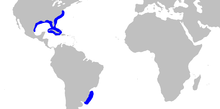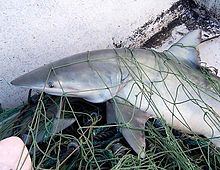Finetooth shark
| Finetooth shark | |
|---|---|

| |
| Scientific classification | |
| Domain: | Eukaryota |
| Kingdom: | Animalia |
| Phylum: | Chordata |
| Class: | Chondrichthyes |
| Subclass: | Elasmobranchii |
| Subdivision: | Selachimorpha |
| Order: | Carcharhiniformes |
| Family: | Carcharhinidae |
| Genus: | Carcharhinus |
| Species: | C. isodon
|
| Binomial name | |
| Carcharhinus isodon (J. P. Müller & Henle, 1839)
| |

| |
| Range of the finetooth shark | |
| Synonyms | |
|
Aprionodon punctatus Gill, 1861 | |
The finetooth shark (Carcharhinus isodon) is a
Valued for its meat, the finetooth shark forms an important component of the
Taxonomy and phylogeny
The finetooth shark was originally described as Carcharias (Aprionodon) isodon by French
As is the case for most Carcharhinus species, attempts to analyze the finetooth shark's
Description
The body of the finetooth shark is slender and streamlined. The snout is long and pointed, with the
The first dorsal fin is high and triangular with a pointed apex, originating forward of the free rear tips of the
-
Distinguishing traits of the finetooth shark include its long gill slits and slender teeth
-
Jaws
-
Upper teeth
-
Lower teeth
Distribution and habitat
In North American waters, the finetooth shark is common and found from North Carolina to the northern Gulf of Mexico, and very occasionally straying as far north as New York. In Central and South American waters, it is rare, but may occur more widely than presently known, having been reported off Trinidad and Guyana, infrequently from the Caribbean Sea, and off southern Brazil from São Paulo to Santa Catarina. The northwestern Atlantic, Gulf of Mexico, and South America populations are distinct, with little interchange between them.[1][8] Old records exist of this species in the eastern Atlantic off Senegal and Guinea-Bissau, but these likely represent misidentifications of spinner sharks (C. brevipinna).[2]
The finetooth shark is often found near
Biology and ecology

Adult and juvenile finetooth sharks form large
Life history
Like other requiem sharks, the finetooth shark is
Female finetooth sharks grow much more slowly and to a larger ultimate size than males.
Human interactions

The finetooth shark has never been implicated in an attack on humans.
Substantial numbers of finetooth sharks are caught in drift
References
- ^ doi:10.2305/IUCN.UK.2021-1.RLTS.T161524A890428.en. Retrieved 19 November 2021.)
{{cite journal}}: CS1 maint: multiple names: authors list (link - ^ ISBN 92-5-101384-5.
- ^ a b c d e Bester, C. Biological Profiles: Finetooth Shark Archived 2011-07-07 at the Wayback Machine. Florida Museum of Natural History Ichthyology Department. Retrieved on May 5, 2009.
- ^ Froese, Rainer; Pauly, Daniel (eds.) (2009). "Carcharhinus isodon" in FishBase. May 2009 version.
- S2CID 39697113.
- PMID 18558373.
- ^ Grace, M.A. (2001). "Field guide to requiem sharks (Elasmobranchiomorphi: Carcharhinidae) of the Western North Atlantic." NOAA Technical Report NMFS 153. pp. 21.
- ^ S2CID 29587318.
- ISBN 0-292-78058-3.
- ISBN 0-89587-195-5.
- S2CID 31178927.
- PMID 20026125.
- ^ a b Ulrich, G.F. Finetooth Shark Carcharhinus isodon Archived 2011-09-28 at the Wayback Machine. South Carolina Department of Natural Resources. Retrieved on May 5, 2009.
- ^ a b c d Carlson, J.K.; Cortés, E. & Bethea, D.M. (2003). "Life history and population dynamics of the finetooth shark (Carcharhinus isodon) in the northeastern Gulf of Mexico". Fisheries Bulletin. 101: 281–292.
- ^ Carlson, J.K., Drymon, J.M. and Neer, J.A. (2007). "Life history parameters for finetooth sharks, Carcharhinus isodon, from the United States South Atlantic Ocean and northern Gulf of Mexico". SEDAR 13 Small Coastal Sharks Data Workshop, Working Document SEDAR 13-DW-11.
- ISBN 1-57806-827-4.





